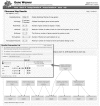GeneWeaver: a web-based system for integrative functional genomics
- PMID: 22080549
- PMCID: PMC3245070
- DOI: 10.1093/nar/gkr968
GeneWeaver: a web-based system for integrative functional genomics
Abstract
High-throughput genome technologies have produced a wealth of data on the association of genes and gene products to biological functions. Investigators have discovered value in combining their experimental results with published genome-wide association studies, quantitative trait locus, microarray, RNA-sequencing and mutant phenotyping studies to identify gene-function associations across diverse experiments, species, conditions, behaviors or biological processes. These experimental results are typically derived from disparate data repositories, publication supplements or reconstructions from primary data stores. This leaves bench biologists with the complex and unscalable task of integrating data by identifying and gathering relevant studies, reanalyzing primary data, unifying gene identifiers and applying ad hoc computational analysis to the integrated set. The freely available GeneWeaver (http://www.GeneWeaver.org) powered by the Ontological Discovery Environment is a curated repository of genomic experimental results with an accompanying tool set for dynamic integration of these data sets, enabling users to interactively address questions about sets of biological functions and their relations to sets of genes. Thus, large numbers of independently published genomic results can be organized into new conceptual frameworks driven by the underlying, inferred biological relationships rather than a pre-existing semantic framework. An empirical 'ontology' is discovered from the aggregate of experimental knowledge around user-defined areas of biological inquiry.
Figures




Similar articles
-
Integrative Functional Genomics for Systems Genetics in GeneWeaver.org.Methods Mol Biol. 2017;1488:131-152. doi: 10.1007/978-1-4939-6427-7_6. Methods Mol Biol. 2017. PMID: 27933523
-
Performing integrative functional genomics analysis in GeneWeaver.org.Methods Mol Biol. 2014;1101:13-29. doi: 10.1007/978-1-62703-721-1_2. Methods Mol Biol. 2014. PMID: 24233775
-
GeneWeaver: finding consilience in heterogeneous cross-species functional genomics data.Mamm Genome. 2015 Oct;26(9-10):556-66. doi: 10.1007/s00335-015-9575-x. Epub 2015 Jun 20. Mamm Genome. 2015. PMID: 26092690 Free PMC article.
-
Cross species integration of functional genomics experiments.Int Rev Neurobiol. 2012;104:1-24. doi: 10.1016/B978-0-12-398323-7.00001-X. Int Rev Neurobiol. 2012. PMID: 23195309 Review.
-
The Global Genome Question: Microbes as the Key to Understanding Evolution and Ecology: This report is based on a colloquium, “The Global Genome Question: Microbes as the Key to Understanding Evolution and Ecology,” sponsored by the American Academy of Microbiology and held October 11-13, 2002, in Longboat Key, Florida.Washington (DC): American Society for Microbiology; 2004. Washington (DC): American Society for Microbiology; 2004. PMID: 33119236 Free Books & Documents. Review.
Cited by
-
Translation of genome-wide association study: from genomic signals to biological insights.Front Genet. 2024 Oct 3;15:1375481. doi: 10.3389/fgene.2024.1375481. eCollection 2024. Front Genet. 2024. PMID: 39421299 Free PMC article. Review.
-
A graph theoretical approach to experimental prioritization in genome-scale investigations.Mamm Genome. 2024 Dec;35(4):724-733. doi: 10.1007/s00335-024-10066-z. Epub 2024 Aug 27. Mamm Genome. 2024. PMID: 39191873 Free PMC article.
-
Combination of transcriptome and Mendelian inheritance reveals novel prognostic biomarker of CTLA-4-related lncRNAs and protective role of nitrogen metabolism pathway in lung adenocarcinoma development.BMC Cancer. 2024 Aug 14;24(1):1009. doi: 10.1186/s12885-024-12777-7. BMC Cancer. 2024. PMID: 39143529 Free PMC article.
-
Resource: A curated database of brain-related functional gene sets (Brain.GMT).MethodsX. 2024 Jun 24;13:102788. doi: 10.1016/j.mex.2024.102788. eCollection 2024 Dec. MethodsX. 2024. PMID: 39049932 Free PMC article.
-
Smoking-informed methylation and expression QTLs in human brain and colocalization with smoking-associated genetic loci.Neuropsychopharmacology. 2024 Oct;49(11):1749-1757. doi: 10.1038/s41386-024-01885-4. Epub 2024 Jun 4. Neuropsychopharmacology. 2024. PMID: 38830989 Free PMC article.
References
-
- Le-Niculescu H, Patel SD, Niculescu AB. Convergent integration of animal model and human studies of bipolar disorder (manic-depressive illness) Curr. Opin. Pharmacol. 2010;10:594–600. - PubMed

